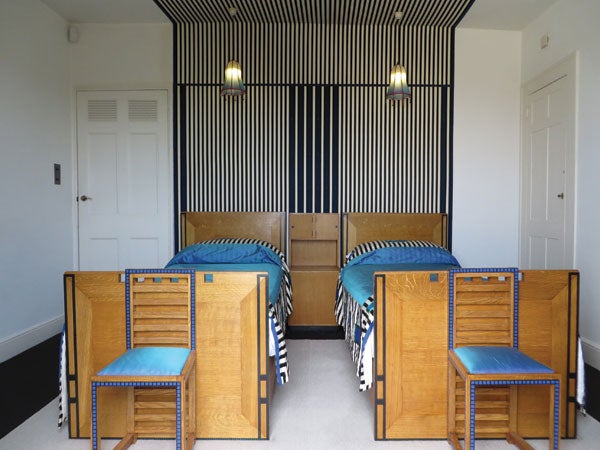
Where else to go in order to see Charles Rennie Mackintosh’s best work up close but… Northampton? Jo Caird visits 78 Derngate
Take a short stroll south-east from Northampton’s neo-gothic town centre, past the modern brick box of the Royal & Derngate theatre complex, the new budget chain hotel and uninspiring office blocks, and you’ll reach a perfectly ordinary, but rather pretty, Georgian terrace. There’s little to suggest from the exterior of 78 Derngate that beyond the matte black front door lies one of the most striking and significant domestic interiors of the 20th century.
No one knows how Northampton model engineer Wenman Joseph Bassett-Lowke came to commission Charles Rennie Mackintosh to remodel his modest Midlands townhouse in 1916. There’s a story about a Glaswegian friend who recommended Mackintosh when he bumped into Bassett-Lowke on holiday in Cornwall, but details are thin on the ground and the go-between has never been identified.
What we do know is that the architect was a long way from his native Glasgow when the Derngate commission came along. Less than ten years after the completion of the Glasgow School of Art — named by the Royal Institute of British Architects in 2009 as the best building in its 175-year history — Mackintosh had fallen out of favour in architectural circles, left the practice where he had made his name and was eking out a living selling watercolours in the midst of a community of artists in London. 78 Derngate was to be his last significant work.

Pictured above: Mr and Mrs Wenman Joseph Bassett-Lowke in front of 78 Derngate
Entry to the house these days is not through the narrow front door, with its triangle-stamped stained glass panels and discreet central lantern, but via a visitor centre a couple of doors down. You can understand why — there’s space at number 82 for a proper reception area, shop, restaurant and gallery — but it’s a shame that visitors can no longer experience Mackintosh’s ‘hall lounge’ in the way he intended, stepping into this glittering cave of a room directly from the normality of the outside world.
While most of Mackintosh’s previous interiors — the art school, the Glasgow tea rooms, the domestic projects — had been dominated by clean white walls and elegant lines, at 78 Derngate he was trying something completely new.
‘It is different from his earlier Glasgow work in that the designs are much darker and geometric,’ says Barbara Floyer, archivist at the house. ‘It represents a different phase in Mackintosh’s work. There is nothing like it elsewhere.’
The ceiling, floor and walls of the hall lounge are matte black like the front door, a stencilled frieze of predominantly yellow triangles at ceiling level drawing the eye and brightening the space. Hanging from the not particularly high ceiling is an enormous chandelier. Mackintosh rotated the staircase in order to enlarge the hall, partially separating the stairs from the room with a square-panelled wooden screen — also black — its lower panels filled with more yellow triangles, this time in stained glass.
Standing in the room for just a few minutes is an almost overwhelming experience. Using it as your main living space would be unbearable. And sure enough, a couple of years after Bassett-Lowke and his new bride, Florence, had moved into the house, Mackintosh was then asked to redesign the hall lounge in more muted colours. What you see today is a re-creation of Mackintosh’s original vision for the space.

Pictured above: Charles Rennie Mackintosh’s drawing for the entrance hall at 78 Derngate
A lot of the house is a re-creation, in fact. 78 Derngate was a starter home for the Bassett-Lowkes, purchased by the engineer’s father as a wedding gift. They moved into the property in 1917, but in 1924 they engaged the German architect Peter Behrens to design a completely new detached property for them elsewhere in the city. They moved out in 1926, selling Derngate to a local architect. It was bought by the Northampton High School for Girls in 1964 and taken into council ownership in the 1990s. The 78 Derngate Northampton Trust has been looking after it ever since, spending around £3 million restoring the house and creating the visitor centre next door.
Not every room is as striking as Mackintosh’s hall lounge. The guest bedroom, where the dazzling stripes of the bed linen extend up the wall behind the beds, across the ceiling and down into curtains on the opposite wall, is original. But the dining room, kitchen and master bedroom, while pleasing to look at and perfectly comfortable, are fairly ordinary.
Letters from Bassett-Lowke to Mackintosh reveal that the engineer was very much involved with the design process, recommending materials, requesting particular details and, indeed, working with another architect altogether on the structural alterations to the building. A founder member of the Design and Industries Association and passionate about the modern, Bassett-Lowke is reported to have said: ‘Have nothing in your home that predates your birth!’

Pictured above: The bedroom at 78 Derngate
Along with abundant enthusiasm, Bassett-Lowke also had some expertise, having spent a year articled to a local architect before founding his mail-order model-train firm. He had the resources to make the project a reality too: while the First World War put a stop to most new building projects, Bassett-Lowke, who also manufactured narrow gauge railways, was able to use his own workforce and obtain scarce materials through his business.
Early in the project he wrote to Mackintosh that he had engaged one of his own draughtsmen to make a scale drawing of the hall so that the architect could start work on the design. Mackintosh may not even have visited the site himself.
But while there are question marks over how much of 78 Derngate Mackintosh actually had a hand in, it’s hard to read the fact that his name wasn’t mentioned at all in a major article on the house published in Ideal Home magazine in 1920 as anything other than a deliberate snub.
‘Mackintosh was not a particularly fashionable architect in 1920 and Bassett-Lowke was a man who liked to create the right impression and so chose to omit him from his article in Ideal Home,’ says Floyer. ‘Much later on [in the 1930s] he actually claimed that Mackintosh had remodelled the whole of his house. I think he was showing off.’ The truth, of course, lies somewhere in between.
Mackintosh’s star had waned after his initial successes, says Pamela Robertson, senior curator and professor of Mackintosh studies at the Hunterian Museum and Art Gallery at the University of Glasgow, partly because ‘taste was changing architecturally towards a more American-inspired beaux-arts classicism — a more formal, symmetrical, emotionless style.’
Mackintosh’s failings as a businessman also had a lot to do it with it. After several successful years working for Honeyman and Keppie, making a name for himself in architectural circles in Glasgow, Mackintosh was made a partner in the firm in 1909. He was so ineffective at bringing in new business, however, that the partnership was dissolved after just four years. The architect never upped this aspect of his game — 78 Derngate and an artist’s studio in Chelsea (which was radically altered soon after it was finished, removing almost all trace of Mackintosh in the process) were the only projects he completed following his move to England in 1913.</p>
The Ideal Home article, which described the guest room at 78 Derngate as ‘the most unique thing we have seen in bedroom decoration’, might have made a significant impact on Mackintosh’s career, had his involvement in the project been flagged up. Instead Mackintosh and his wife, Margaret, muddled along as best they could, paying the rent with the earnings from textile designs, watercolours and some commercial design work (including for Bassett-Lowke).
In 1923 the couple moved to the south of France, where life was cheaper, Mackintosh dedicating himself to painting and only returning to the UK a few months before his death of cancer of the tongue in 1928. Margaret sold the contents of his estate for a paltry sum and died five years later.
So the story of 78 Derngate, just like the story of Mackintosh’s life, is bittersweet. Mackintosh’s work on the house, some of the boldest and most original of his career, could have been a moment of turnaround for the architect. A combination of poor business acumen and bad timing put paid to that. Had the circumstances been different, who knows what he might have gone on to achieve?
Main image and drawing courtesy the Hunterian, University of Glasgow, others courtesy the 78 Derngate Northampton Trust






